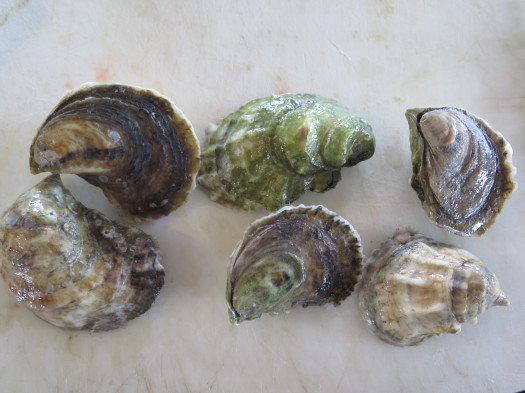Glidden Point “Single-Lease” Reserves
Aug 21, 2014

Glidden Point Single-Lease Reserves, left to right: Bristol Shore, Ledge, and Newcastle Shore
Most serious ostreaphiles have come across Glidden Points, the standardbearer against which all eastern oysters must be measured. For more than 25 years, back before oysters were hipsters, Barb Scully farmed perfect specimens in her enviable Damariscotta River leases in Maine. In 2016 Hannah Grady and Ryan McPherson took over and maintained the same impeccable standards. Perfect means: 3.5 inches, deep cup, strong shell, intense brine balanced by rich, savory, lingering sweetness. You can count on that from any Glidden Point Select, but few people have had the chance to differentiate between individual leases.
There are four different lease sites on the Damariscotta, each having unique bathymetry. Some are really deep, some shallow; some warmer, some colder, and all have different currents and different bottom consistency. All of that, of course, shows up in the physicality of the oysters. Recently, I had the sublime pleasure of tasting through these “single-vineyard” reserves at Mine Oyster, the all-star oyster bar in Boothbay Harbor that has become the most reliable place in the country to find great Glidden Points. Below are Barb Scully’s original descriptions of her three best sites, with my tasting notes at the end in italics. If you’re fortunate, you might be able to single some out in your next Glidden Point order. Bon app.
Newcastle Shore
Grown on my most shallow lease. The substrate is clay and sand, and the depth is in the 1-12 foot range. They are fed by phytoplankton blooms in the shallow waters of the upper Damariscotta River and Great Salt Bay. The growth rate here is extremely fast, but the icing in the winter can be severe due to the shallow depths, which can push the oysters down into the clay/sand bottom and slow the growth. This makes the oysters on this lease vary greatly in their growth rates, as the ones at the surface grow quickly with easy access to food and current, and the ones pushed into the clay and sand grow slowly as all their metabolic needs must be filtered through a thick layer of clay and sand. These oysters are free of barnacles because they are usually covered with silt or clay, and super white and clean once they are purged and cleaned for market.
Notes: The daintiest of the three, in size and shell. Intense, mouth-filling umami savoriness, with a touch of katsuobushi smokiness. Extraordinary.
Bristol Shore
Grown on my deepest lease, from 20-40 feet. The substrate here varies from clay to shell hash, but the cold temperatures slow the growth rate considerably, meaning these oysters take 4-5 years to grow to market size, and usually acquire barnacles during that time. While the barnacles get scraped off post-harvest, the shells usually look dark brown to reddish-brown and retain evidence of the barnacle ‘scars.’ The Glidden Point oysters from these deep, cold waters are possibly the easiest to shuck, as the shell hardness is remarkable and unmatched. These Glidden Points have a deep cup and hardy shelf-life.
Notes: Absolutely perfect shells. Deep, deep cups. These are the mildest in flavor of the three, with full salt but less sweetness and a bit more metal.
Ledge
These oysters combine the qualities and characteristics of the Newcastle shores and Bristol Shores sites. They are grown in the shallow waters of South Bristol and Edgecomb leases where the water is frigid cold during most of the year, but for a brief time in the summer it is super warm because it is shallow. This produces an oyster of slow growth rate which boasts a deep cup, superb shell hardness, and advanced age (usually 4-6 years old), but super-clean shell with a green tint. These oysters are unbelievably difficult to harvest because they are grown in high current areas, often on shallow ledges, where it is difficult for even an advanced diver to harvest safely. These are my favorite; partially because they are such a challenge to grow and harvest in these extreme conditions, and partially because no one else in the world is doing this, nor in their right mind would even try to do things this way. These are by far the most beautiful oyster I have learned to produce. My pride and joy.
Notes: Amazingly sweet, to balance the concentrated brine. Like a razor clam and corn chowder. There’s a unique brightness to the Ledge flavor. The perfect oyster.
« PREVIOUS: Glacier Points in Halibut Cove, Alaska
» NEXT: Shaw’s 26th Annual Oyster Fest, Sept 26
 Recent Posts
Recent Posts
